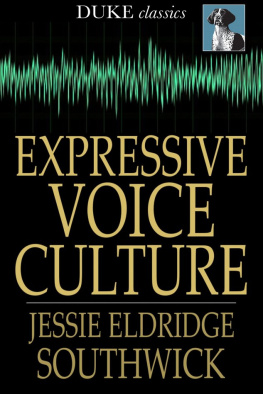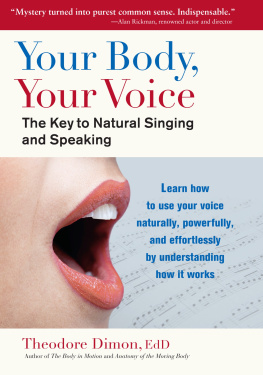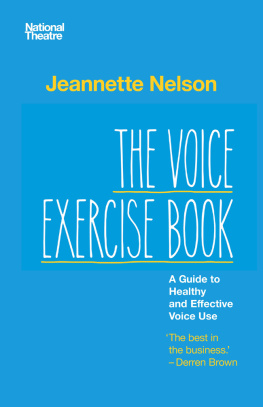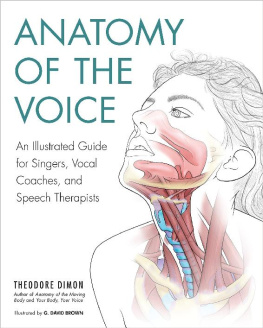EXPRESSIVE VOICE CULTURE
INCLUDING THE EMERSON SYSTEM
* * *
JESSIE ELDRIDGE SOUTHWICK
*
Expressive Voice Culture
Including the Emerson System
ISBN 978-1-62011-519-0
Duke Classics
2012 Duke Classics and its licensors. All rights reserved.
While every effort has been used to ensure the accuracy and reliability of the information contained in this edition, Duke Classics does not assume liability or responsibility for any errors or omissions in this book. Duke Classics does not accept responsibility for loss suffered as a result of reliance upon the accuracy or currency of information contained in this book.
Contents
*
Preface
*
The Emerson System treats the voice as a natural reporter of theindividual, constantly emphasizing the tendency of the voice to expressappropriately any mental concept or state of feeling.
This treatise is a setting forth of methods and principles based upon thisidea with a fuller elaboration of the relation of technique to expression.No attempt is here made, however, to present more than an individualcontribution to this broad subject.
J. E. S.
Chapter I - Principles of Voice Culture
*
The first essential to one beginning the study of voice culture is anappreciation of the real significance of voice development. We mustrecognize at once the fact that the voice is a natural reporter of theconditions, emotions, thoughts, and purposes (character and states orconditions) of the individual. The ring of true culture in the voice isthat perfect modulation of tone and movement which, withoutself-consciousness, communicates exactly the meaning and purpose whichimpel the utterances of the speaker.
It is almost impossible for any person to cultivate vocal expression tothe best advantage without an intelligent and sympathetic teacher; helacks the perspective upon himself which is necessary in order to correcthis individual faults and draw out his most effective powers. Then, again,he needs that personal supervision and direction of his efforts which willallow his mind to be constantly occupied with thoughts and principles, andrelieve him of all temptation to watch his own performances as such. Butit is necessary that the student should have a simple and logical basisfor practice, however great may become the variety of its application.
That the voice is naturally expressive is shown in the fact that evenwhere there is no possible suggestion of cultivation we instinctively readthe broad outlines of meaning and feeling in the tones and inflections ofthe voice. May it not therefore be possible that a finer culture willreveal all the subtle shades of thought and feeling, and a morediscriminating judgment be able to detect these, just as the ethnologistwill reconstruct from some crude relic the history of an earliercivilization?
We must remember, too, that first of all the voice is a vital instrument.The physical condition affects most noticeably the quality, strength, andmovement of the voice. Hence we see that physical health is essential to agood voice, and the proper use of the voice is itself one of the mostinvigorating exercises that can be practised. All the vital organs arecalled into healthful action through this extraordinary manipulation ofthe breath, and the nervous system, both vitally and emotionally, receivesinvigoration.
In the beginning, therefore, such vital conditions as are essential to theproduction of tone should be considered.
First, a standing position, in which the vital organs are well sustained,is essential. One cannot even breathe properly unless one stands well. Theweight should be mainly upon the balls of the feet, and the crown of thehead so positively elevated as to secure the erectness of the spinalcolumn. This will involve the proper elevation of the chest, the essentialfreedom of respiration, and the right sustaining tension of the abdominalmuscles.
(a) Take standing position as follows: weight on balls of feet,heels together, toes slightly apart; line of gravity from crown of head,well lifted, to balls of feet; the ear, point of shoulder, and point ofhip should be in line; muscles of the thigh strong in front; ribs welllifted so that front line from waist to throat is lengthened to fullextent; back kept erect, and curve at waist not emphasized. Breathestrongly and deeply several times.
To secure the elevation of the ribs the hands may be placed under thearms, as high as possible, fingers pointing down; then try to turn orpress the ribs up and forward with strong action of hands, breathingfreely and emphasizing strength in waist muscles. Sustain the ribsin this elevated position, and thus uplift the chest. Keep shoulders free.Drop hands to sides again.
(b) Take half a step forward; sustain weight on advanced foot; donot change position of retired foot, but keep the sense of purchase in it.The chest should be carried forward of the abdomen and the abdominalmuscles given their best leverage by a slight bending forward from thehips. (Bending forward must not be done by any dropping of the chest, orshortening of the line at waist through relaxation.) This position must belight, active, buoyant, and reposeful.
A constant sense of easy balance should be developed through poisingexercises.
The habit of healthful and powerful respiration should be established byphysical exercise for that purpose, and the right manipulation of breathin tone production should be secured by the nature of the voice exercises.Any vocal exercise which involves in the very nature of its production agood control of breath becomes, by virtue of that fact, a good breathingexercise as well.
If the voice be perfectly free, it is then capable of expressing truly allthat the person thinks and feels. The first desirable end sought, then, isfreedom. What is freedom, and how secured? When all cavities of resonanceare accessible to the vibrating column of air the voice may be said to befree. By cavities of resonance is meant the chest (trachea and bronchialtubes), the larynx, pharynx, the mouth, and the nares anterior andposterior, or head chambers of resonance. The free tone is modifiedthrough all its varieties of expression by those subtle changes in form,intensity, movement, inflection, and also direction, which are too finefor the judgment to determine, or even observe successfully. Thesevarieties are made possible by the very organism of the voice, which isvital, not mechanical, and are determined by the influences working fromthe mind through the nerves which control this wonderful livinginstrument. This is governed by the law of reflex action, by whichstimulation of any nerve center produces responsive action in other partsof the body. The voice will obey the mind. Right objects of thought willinfluence it much more perfectly and rapidly than the mere arbitrarydictates of calculation.
Right psychology would be the only thing necessary to the thoroughcultivation of the voice if the conditions were so perfect that there wereno habits of stricture and our instrument were thus in perfect tune. Andin spite of the fact that it is not usually found in perfect tune, theinfluence of practice under right mental conditions is the most potent andindispensable part of voice culture. Let this fact not be lost sight ofwhile we are discussing those more technical methods of training which aredesigned to tune and regulate our instrument.
First, freedom of voice is attained (technically speaking) by rightdirection of tone and vital support. A few words of explanation will makethis patent.











